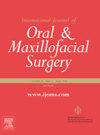Twenty years of experience with lesions involving the temporomandibular joint and adjacent structures complex
IF 2.2
3区 医学
Q2 DENTISTRY, ORAL SURGERY & MEDICINE
International journal of oral and maxillofacial surgery
Pub Date : 2025-01-02
DOI:10.1016/j.ijom.2024.12.005
引用次数: 0
Abstract
With their close anatomical relationship, the temporomandibular joint (TMJ), mandibular ramus, skull base, ear, and infratemporal fossa make up a complex structure that may collectively be referred to as the ‘TMJ and adjacent structures complex’ (TASC). This study presents the neoplasms that may be encountered in the TASC region and their classification, which may be useful for the surgical treatment. Data of 1022 consecutive patients treated with resection of TASC neoplasms from May 2000 to October 2022 were reviewed. Pathology outcomes were classified according to the World Health Organization classification and Bone Tumors (Dorfman and Czerniak). Extent of the lesions was analysed based on imaging modalities. Ten tissue origins were observed. Synovial lesions accounted for the highest proportion of pathologies (56.0%). Regarding their biological behaviour, the lesions could be divided into pseudotumours (12.8%), benign tumours (28.4%), intermediate tumours (57.0%), or malignant tumours (1.8%). All lesions originated from one of four sites: lesions intrinsic to the TMJ (91.5%), extending from adjacent structures (7.7%), distant metastatic spread (0.4%), and multiple general foci (0.4%). In conclusion, it is hoped that knowledge of the histopathological and biological features will facilitate the surgical treatment of these pathologies in a rational, minimally invasive, and functional manner.
治疗颞下颌关节及邻近结构复合体病变的二十年经验。
颞下颌关节(TMJ)、下颌支、颅底、耳和颞下窝具有密切的解剖关系,构成了一个复杂的结构,可统称为“颞下颌关节及邻近结构复合体”(TASC)。本研究介绍了TASC区可能遇到的肿瘤及其分类,为手术治疗提供参考。回顾2000年5月至2022年10月连续1022例TASC肿瘤切除术患者的资料。病理结果根据世界卫生组织分类和骨肿瘤分类(Dorfman和Czerniak)进行分类。根据影像学分析病变范围。观察到10个组织起源。滑膜病变占病理的比例最高(56.0%)。根据其生物学行为,病变可分为假肿瘤(12.8%)、良性肿瘤(28.4%)、中间肿瘤(57.0%)和恶性肿瘤(1.8%)。所有病变均起源于以下四个部位之一:TMJ内生性病变(91.5%)、邻近结构延伸(7.7%)、远处转移扩散(0.4%)和多发全身病灶(0.4%)。总之,希望对组织病理学和生物学特征的了解将有助于以合理、微创和功能性的方式对这些病理进行手术治疗。
本文章由计算机程序翻译,如有差异,请以英文原文为准。
求助全文
约1分钟内获得全文
求助全文
来源期刊
CiteScore
5.10
自引率
4.20%
发文量
318
审稿时长
78 days
期刊介绍:
The International Journal of Oral & Maxillofacial Surgery is one of the leading journals in oral and maxillofacial surgery in the world. The Journal publishes papers of the highest scientific merit and widest possible scope on work in oral and maxillofacial surgery and supporting specialties.
The Journal is divided into sections, ensuring every aspect of oral and maxillofacial surgery is covered fully through a range of invited review articles, leading clinical and research articles, technical notes, abstracts, case reports and others. The sections include:
• Congenital and craniofacial deformities
• Orthognathic Surgery/Aesthetic facial surgery
• Trauma
• TMJ disorders
• Head and neck oncology
• Reconstructive surgery
• Implantology/Dentoalveolar surgery
• Clinical Pathology
• Oral Medicine
• Research and emerging technologies.

 求助内容:
求助内容: 应助结果提醒方式:
应助结果提醒方式:


